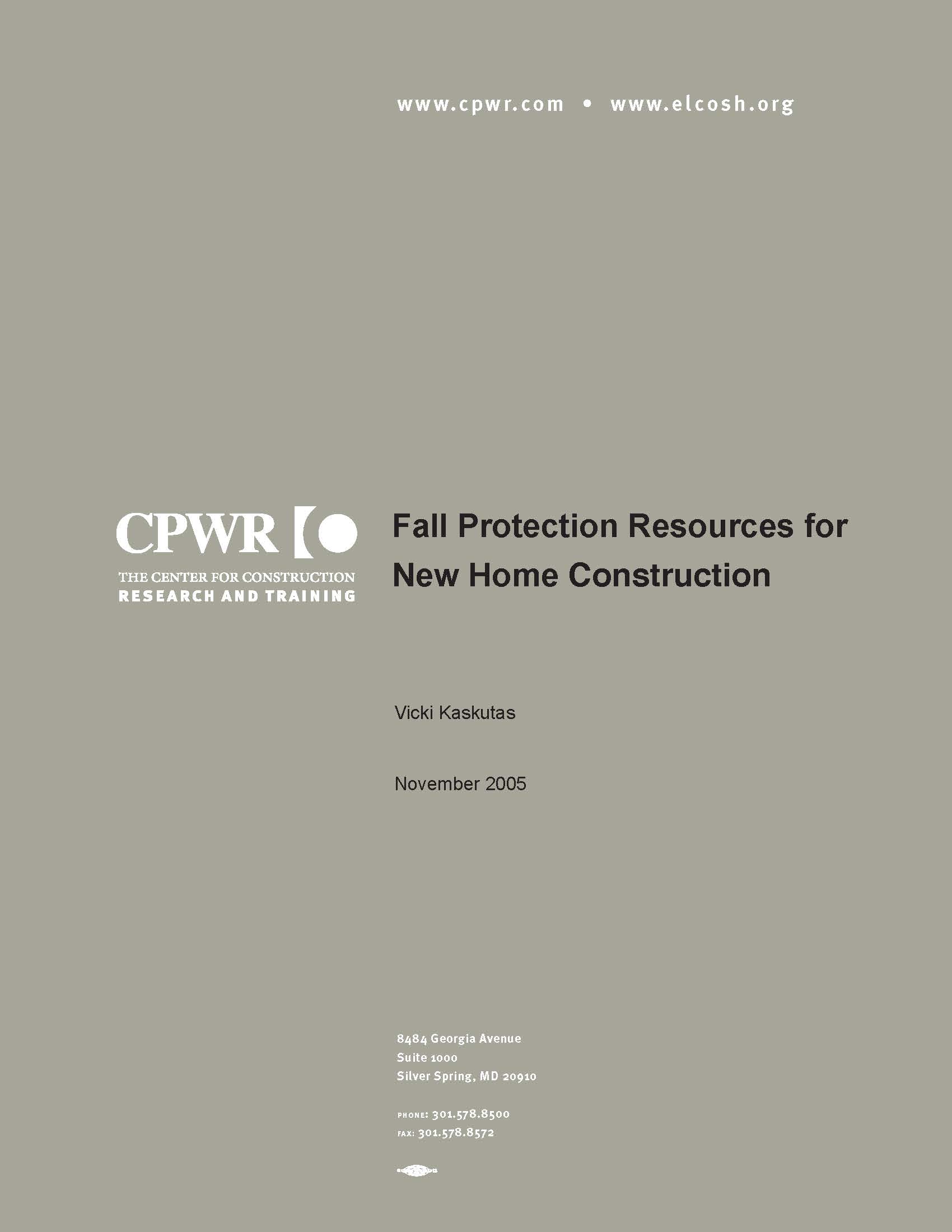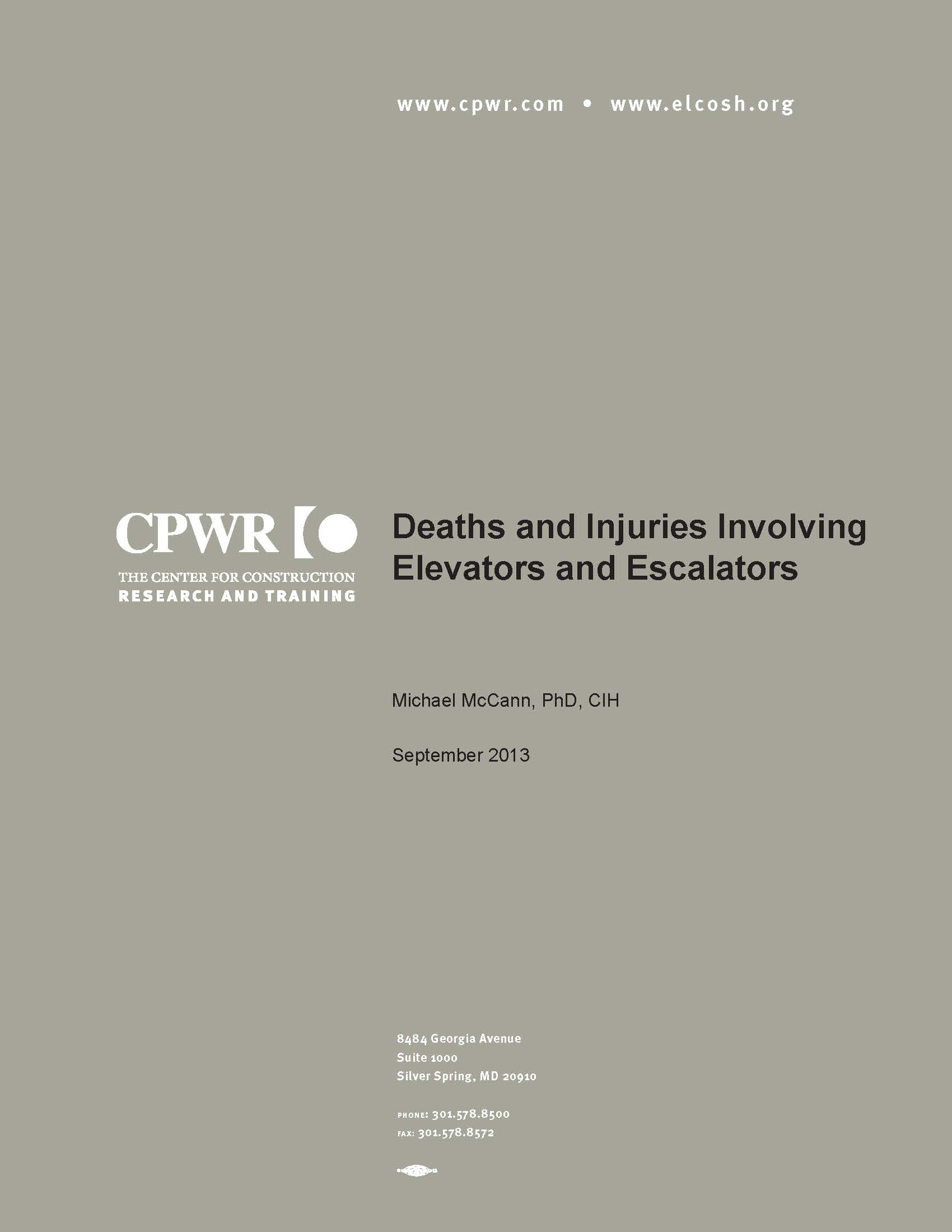Safety Hazards
SETU: Safety in Excavation and Trenching, for yoU — A training and decision-making tool for worker safety in excavation and trenching operations in construction
Erica Cochran Hameen, PhD, Shailendra Singh, Shalini Priyadarshini, Zhan Shi. CPWR Small Study. 2024.
This research uses a mixed methods framework to understand the reasons for the limited adoption of proven protective systems during trenching and excavation.
Improving the Assessment of Noise Exposure and Warning Signal Audibility on Construction Sites
Nikolina Samardzic, Aslihan Karatas, Behzad Esmaeili, and Christian Hammond. CPWR Small Study. 2023.
Over half of construction workers face noise levels that can damage hearing. This study’s comparison of traditional and binaural (two-ear) noise measurement tools underscores the former’s limitations, emphasizing the need for more accurate measurements to protect against noise-induced hearing loss. The findings also shed light on challenges workers face in identifying warning signals.
Using Virtual Technology for Job Hazard Analysis
Zia Ud Din, Christiane Spitzmueller, Hardith Suvarna Murari. CPWR Small Study. 2022.
This study looks at the effectiveness of the Job Hazard Analysis application using two interventions, a VR-based application for JHA and a paper-based JHA.
Struck-by Hazards, Barriers, and Opportunities in the Construction Industry -- 2022 Survey Results
Eileen Betit, Grace Barlet, and Jessica Bunting. August 2022.
This survey explores causes of struck-by injuries; barriers to their prevention; and examines measures to protect workers and barriers to implementing them.
Highlighted Findings from a CPWR Survey on Underlying Causes of Falls from Heights
Grace Barlet, Rosa Greenber, and Jessica Bunting. August 2022.
To better understand why serious falls from heights continue to occur with such frequency despite being preventable, CPWR surveyed nearly 500 people who experienced, witnessed, or investigated a workplace fall incident.
Intelligent Hearing Protection for Construction Workers Exposed to Hazardous Noise
Tuyen Le, Ph.D. and Kehinde Elelu. March 2022.
This Small Study aimed to increase auditory awareness of workers exposed to loud noise with a new hearing protection technology that uses artificial intelligence to both amplify safety-critical sounds and greatly attenuate ambient noise.
A Practical Model for Measuring and Mitigating Safety Risks of Using UAS in Construction
Yelda Turkan and Yiye Xu. January 2022.
Because there is little research on the possible dangers to workers of using unmanned aerial systems (UAS) on construction sites, this study developed a practical model to establish, assess, and improve mitigation programs to control safety risks from UAS.
Protocol for Assessing Human- Robot Interaction Safety Risks
Chukwuma Nnaji, John A. Gambatese, and Ifeanyi Okpala. September 2021.
This study developed a practical process and tools for practitioners to identify and quantify safety risks when using robotics and automation. Both the process and the tools are designed to improve safety when using technologies such as wearable robots, remote operated robots, and onsite automated robots.
Using Unmanned Aerial Systems for Automated Fall Hazard Monitoring in High-rise Construction Projects
Masoud Gheisari, Behzad Esmaeili, Jana Kosecka, and Abbas Rashidi. June 2020.
One emerging technique for using Unmanned Aerial Systems (UASs)—often referred to as drones—to improve construction site safety applies image processing and computer vision methods to extract information from data the UASs capture with high-resolution cameras. Researchers have recently focused on developing techniques to automate operations such as 1) detecting job site hazards and safety-related issues and 2) conducting automated and semi-automated safety inspections. This project used UASs to collect images and combine them with novel computer vision techniques to create an automated fall hazard detection and monitoring system. Through a case study that looked at a high-rise building, the researchers investigated implementation of UASs to monitor guardrails near unprotected edges and openings.
Embedded Safety Communication System for Robust Hazard Perception of Individuals in Work Zones
Jee Park and Sayan Sakhakarmi. September 2019.
This project developed an Embedded Safety Communication System to help workers in harsh construction environments sense hazards better than they do just through their innate abilities, such as vision and hearing. Vibrating motors and sense of touch form the heart of this wearable system, and the study identified optimal spacing and configuration for motors embedded in the back of a waist belt worn by a worker.
Holographic Visual Interaction and Remote Collaboration in Construction Safety and Health
Fei Dai and Abiodun Olorunfemi. April 2018.
Mixed-Reality technology blends virtual reality with the physical world, enabling wearers of a mixed reality headset to view the physical environment as well as notes, objects and information appended to real-world objects, and then to share their view with others via wireless networks. Applying this technology to safety communication would permit onsite and office personnel to collaborate about jobsite hazards in real-time with shared visuals. Researchers enrolled 53 construction personnel (including project managers, superintendents, and safety officers) in an experiment to evaluate the potential of mixed reality as a means of safety communication. Participants were paired, with one on the jobsite wearing a Microsoft Hololens mixed-reality headset, and another in the office speaking with his colleague while sharing his view on a tablet computer. After exchanging information about jobsite hazards, participants were asked to compare the new technology with more conventional means of safety communication, such as phone calls, videoconferencing, e-mails, and traveling to the jobsite to talk face-to-face.
Reducing Highway Construction Fatalities Through Improved Adoption of Safety Technologies
Chinweike Eseonu, John Gambatese, Chukwuma Nnaji. March 2018.
Highway construction is commonly associated with high rates of worker accidents. Nevertheless, the diffusion of safety technologies such as work zone intrusion alert technology (WZIAT) within the highway construction industry is limited due to concerns about technology effectiveness, cost implications of adopting a technology, and failure to perceive potential safety and cost benefits. This study attempts to develop tools and identify effective processes that could be used to improve the adoption of work zone safety technologies using work zone intrusion technology as a case study.
Improving Work Zone Safety Utilizing a New Mobile Proximity Sensing Technology
Yong Kwon Cho, Xiaoyu Yang, Jeewoong Park. July 2017.
Struck-by injuries are one of construction’s “fatal four” leading causes of death on the job; collisions between heavy equipment and workers on a busy jobsite are all too frequent. To reduce this risk, researchers designed and tested a proximity sensing and alert system using Bluetooth Low Energy (BLE) technology. The system monitors the location and direction of moving equipment and alerts both equipment operators and workers on the ground to collision hazards.
Fall Protection Resources for New Home Construction
Vicki Kaskutas. September 2014.
Falls from height remain the most common cause of construction worker fatalities, and falls continue to happen at an alarming rate – especially in residential construction. OSHA has recently imposed more stringent safety standards on the sector, but many residential construction contractors still have limited knowledge of the array of fall protection devices commercially available. The research team sought to develop a user-friendly online inventory (http://www.ot.wustl.edu/fptech/homepage.htm) of fall protection devices suitable to residential construction. Leveraging substantial experience in construction fall prevention research, and an extensive network of industry contacts, the Washington University team developed a web-based catalogue users could search either by the type of fall prevention device or by the stage of construction in which it is used.
Use and Re-use of Formwork: Safety Risks and Reliability Assessment
Gambatese, John, Andre Barbosa, and Amrutha Das. September 2014.
Carpenters employed by concrete contractors spend much of their time assembling, erecting and dismantling the plywood forms for concrete pours, forms which are usually reused on subsequent projects. Researchers mapped out the work tasks involved, then used interviews with carpenters, as well as a review of OSHA case reports, to identify the work tasks entailing the highest risks. The team also tested plywood samples in the laboratory to test how well they retained strength after repeated use.
Field Tool for On-Site Biomechanical Analysis During Ladder Climbing
Lee, SangHyun PhD and Thomas J. Armstrong, PhD. April 2014..
Falls from ladders are a leading cause of death among construction workers and may be caused by lost balance, lost hand grip, and missed/slipped footing. In the laboratory setting, equipment is available to translate surface markers into skeleton-based motion using computer programs to identify ergonomic stressors. Research goals were to study forces on hands and feet in order to predict them from video, to test the ability of the motion data tool to collect information during ladder climbing in a laboratory, to develop software capable of translating the data into available file formats to be used by existing biomechanical computer programs, and to develop a tool for use in the field.
Deaths and Injuries involving Elevators or Escalators
Revised. Michael McCann. 2013.
Using data from the BLS’ Census of Fatal Occupational Injuries, the Consumer Product Safety Commission, NIOSH’s Fatality Assessment Control and Evaluation (FACE) program, and other sources, this report gives statistics on deaths and injuries from incidents involving elevators and escalators, including types of activities and cause of death to workers. After thoroughly investigating the hazards and problems through data, the report concludes with recommendations to improve worker and passenger safety and prevent senseless injuries and deaths from occurring.
Reaching Higher - Recommendations for the Safe Use of Mast Climbing Work Platforms
Susi, Pam and CPWR Mast Climbing Work Group. 2010
Knowledge and Recommendations of Sales Personnel Regarding Pneumatic Nail Gun Safety
Lipscomb, Hester. 2010
A CPWR-funded research team led by Hester Lipscomb of Duke University discovers some source of misinformation was given to nail gun buyers in almost 75 percent of the 217 businesses visited.
- Duke Medicine press release: Staff selling nail guns know little of their dangers, study finds
- Abstract from American Journal of Industrial Medicine
- More information on eLCOSH – Nail Guns: Injuries, Productivity and Recommendations
Evaluation of an Intervention to Reduce Trunk Flexion among Stud Workers
Nathan Fethke and Lauren Grant. February 2010.
Development of Design Interventions for Preventing Falls from Fixed Ladders
Thomas J. Armstrong, Ph.D., James Ashton-Miller, Ph.D., Charles Woolley, Janet Kemp, Justin Young, Kim Hogene. April 2008
Falls are the leading cause of death among construction workers. In this report, and poster session, Dr. Tom Armstrong and researchers at the University of Michigan Center for Ergonomics share their study results of hand and foot forces while climbing on fixed ladders.
Development of Design Interventions for Preventing Falls from Fixed Ladders
Strategies to Prevent Trenching-Related Injuries and Deaths
Plog, Barbara A., Barbara Materna, Jim Vannoy, and Marion Gillen. 2006
Uses data, interviews with trenching industry and safety experts, and site visit observations to develop new ways to improve trenching safety. Recommends targeting small and inexperienced excavation companies for safety efforts.
Compactor Overturns and Rollover Protective Structures
Myers, Melvin L. 2004
Analyzes 58 OSHA reports of overturn-related deaths of operators of compactors (steamrollers) in 1986-2002 to learn whether a lack of rollover protective structures (ROPSs) – and failure to use seatbelts – contributed to the deaths. Recommendations include promulgation of an OSHA standard for compactors requiring the use of ROPSs and seatbelts in construction, operator-training requirements, design changes, and further safety research.
Occupational Injuries among Construction Workers Treated at the George Washington University Emergency Department, 1990-97.
Hunting, Katherine L., Judith Anderson Murawski, and Laura S. Welch. 2004
Chart book shows fatal and nonfatal injuries treated as a result of 2,916 emergency room visits by constructionworkers. Data is organized by demographics, occupation, cause of injury, diagnosis, and injured body part to illuminate trends and to point up ways to reduce injuries in each trade.
Explosion and Asphyxiation Deaths among Contract Employees in Industrial Plants
McCann, Michael. 2003
This summary, prepared for the U.S. Chemical Safety and Hazard Investigation Board, finds that 91 contract employees on construction projects at industrial plans in 1992-2001 were killed by explosions or asphyxiation and recommends changes, including new training and procedures, particularly for welding.
Explosion and Asphyxiation Deaths among Contract Employees in Industrial Plants
Safety Hazards to Workers in Modular Home Construction
Analyzes video observations and questionnaires given to workers and employers on four modular home construction project and finds unique safety hazards – particularly for fall and crushing or “struck by ‘’ along with a lack of worker protections, including safety training. Accompanying video posted at
http://www.elcosh.org/en/video/10/a000037/safety-hazards-to-workers-in-modular-home-construction.html
Ready Mixed Concrete Truck Drivers: Work-Related Hazards and Recommendations for Controls
Clark, Nancy, Jonathan Dropkin, and Lee Kaplan. 2001
After analyzing data from OSHA and 23 ready mixed concrete plants in the United States, the authors identify slips, trips, and falls, impact/mechanical hazards during equipment operations, silica exposures during mixer cleanout, and other risks, then recommend a comprehensive safety and health program and other steps to prevent injuries and illnesses.
An Investigation of Surface Slip Resistance On Structural Steel
Proposed wording for a specification for slip-resistance on structural steel to protect ironworkers and other trades from falls; demonstrates that commercially available slip-resistant paints could meet such a standard, while commercially available portable slip meters could objectively measure compliance.

Health Hazards to Construction Workers During the Demolition of Two Tenement Buildings.
Analyzes worksite exposures to lead, dusts, and safety hazards among demolition workers.

Patterns of Deaths among Construction Workers, California 1979-81
Summarizes California Department of Health Services data showing, among other things, that construction workers die an average of 8 to 12 years earlier than members of some low-risk white-collar occupations.


























